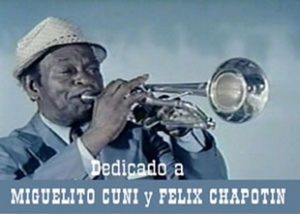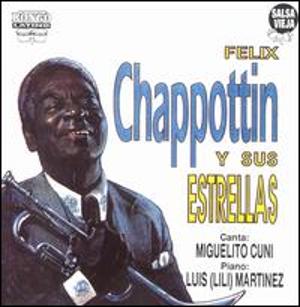Felix Chappottín Lage, was born in Havana on March 31, 1907. His study facilities led him to join the Guanajay children’s band, pueblito where he occasionally lived by that date. As a curious and interesting fact we can add that when Luciano Pozo González (Chano) was 8 years old his mother Encarnación González dies, and this makes it possible for Félix’s father, Julio Chappottín, to join Felix’s mother, Natalia Lage, who ends up to raise Chano Pozo.
In their youthful life they were two very well-born foster brothers, according to the comments of those who knew them.
In 1924 he entered “La Estudiantina Orquídea de Américo González”, and later joined the already famous “Septeto Habanero” in 1927, as a substitute for trumpeter Rafael Hernández, (El piche), being the second trumpeter who played He is in our country and possibly in the World.
For reasons very inherent to the musical class, Felix leaves the Septeto Habanero and begins to move to the following groups: Septeto Colín, Munamar, Universe, Alabama, Bologna, and together with the legendary Jesús Gutiérrez (Tata) they organize the Sextet Bolero. Later he joined the group Sexteto Carabina de Ases, but Chappottín is not supported in any group and continues his journey through the whole America, La Gloria Cubana, Orquesta Anacaona, directed by the Castro sisters. Later it is inserted in the “Blue Set” directed by his brother Chano. However every time they called him from a comparsa, there was “Chapo” with his trumpet.
Acting in the well-named group “Jóvenes del Cayo” at the end of the 1940s, Arsenio Rodríguez comes to look for him. Chapottín without thinking twice is enrolled next to the Wonderful Blind where he finally settles in this group, one of the best sonero of the trumpet in Cuba. Next, we will carry out as much as possible the recordings of this Cuban musician in the “Septeto Habanero”.
As of that moment, the original of Arsenio Rodriguez All Stars band was transformed into the Conjunto Estrellas Chappottín y sus. The group was headed by Felix Chappottín with Luis (Lilí) Martínez Griñán as the arranger and Miguelito Cuni the singer. Under the direction of Felix Chappottín, only to be compared with Louis Satchmo Armstrong, the band achieved international fame, dancers who move and have fun in different parts of the world.
The key to this success known by Chappottín and his Estrellas has been his fidelity and pride in the exhibition of African cultural elements in the son as a Cuban artistic manifestation and music. This constant preservation for years has entertained and dancers who love Caribbean music all over the world.
http://youtu.be/l2XXsRnaHBo
The son and grandson of Felix Chappottín have been in charge of Conjunto Chappottín and its stars since Felix died in 1983. At present, his main task of leading the group has been to ensure the continuity of the repertoire of legendary bands, while enriching it. with new creations. The current direction has maintained the sonoric and rhythmic identity of the band as was taught by the pioneers of unforgettable Cuban folk dance music. During two visits a few months ago, this effort has been very well and welcomed with enthusiasm by the peoples of the Dutch Caribbean islands of Curacao and Aruba. ”
EL INOLVIDABLE “FÉLIX CHAPPOTTÍN Y SUS ESTRELLAS” TODAVÍA PRESENTES !.
Félix Chappottín Lage, nació en La Habana el 31 de marzo de 1907. Sus facilidades de estudios lo llevaron a ingresar en la banda infantil de Guanajay, pue-blito donde ocasionalmente vivía por aquella fecha. Como dato curioso e interesante podemos agregar que cuando Luciano Pozo González (Chano) contaba 8 años su madre Encarnación González fallece, y esto hace posible que el padre de Félix, Julio Chappottín se una a la mamá de Félix nombrada, Natalia Lage, quién termina de criar a Chano Pozo.
En su vida de juventud fueron dos hermanos de crianza muy bien llevados, según los comentarios de los que los conocían.
En el año 1924 ingresa en “La Estudiantina Orquídea de Américo González”, para más tarde ingresar en 1927 al ya famoso “Septeto Habanero”, como sustituto del trompetista Rafael Hernández, (El piche), siendo a su vez el segundo trompetista que interpreta el son en nuestro país y posiblemente en el Mundo.
Por razones muy inherente a la clase musical, Félix abandona al Septeto Habanero y comienza a trasladarse a las siguientes agrupaciones: Septeto Colín, Munamar, Universo, Alabama, Boloña, y junto al legendario Jesús Gutiérrez (Tata) organizan el Sexteto Bolero. Más tarde integra la agrupación Sexteto Carabina de Ases, Pero Chappottín no se sostiene en ningún grupo y continúa su periplo por el conjunto América, La Gloria Cubana, Orquesta Anacaona, dirigida por las hermanas Castro. Posteriormente se inserta en el “Conjunto Azul” dirigido por su hermano de crianza Chano. No obstante cada vez que lo llamaban de una comparsa, allá iba “Chapo” con su trompeta.
Actuando en el bien nombrado conjunto “Jóvenes del Cayo” a finales de los años 1940, lo viene a buscar Arsenio Rodríguez. Chapottín sin pensarlo dos veces se enrola junto al Ciego Maravilloso donde al fin se asienta en esta agrupación, uno de los mejores sonero de la trompeta en Cuba. A continuación vamos a realizar en lo posible las grabaciones de este músico cubano en el “Septeto Habanero”.
A partir de ese momento, el original de Arsenio Rodríguez Todos Estrellas banda se transformó en el Conjunto Estrellas Chappottín y sus. El grupo estaba encabezado por Félix Chappottín con Luis (Lilí) Martínez Griñán como el arreglista y Miguelito Cuni el cantante. Bajo la dirección de Félix Chappottín, sólo para ser comparado con Louis Satchmo Armstrong, la banda alcanzó la fama internacional, bailarines que se mueven y divertida en diferentes partes del mundo.
La clave de este éxito conocido por Chappottín y sus Estrellas ha sido su fidelidad y su orgullo en la exhibición de los elementos culturales africanos en el hijo como manifestación artística cubana y la música. Esta preservación constante durante años ha entretenido y bailarines amantes de la música caribeña en todo el mundo.
El hijo y nieto de Félix Chappottín han estado a cargo del Conjunto Chappottín y sus estrellas ya que Félix murió en 1983. En la actualidad, su principal tarea de dirigir el grupo ha sido asegurar la continuidad del repertorio de bandas legendarias, mientras que la enriquece con nuevas creaciones. La dirección actual ha mantenido la identidad sonoric y rítmica de la banda como fue enseñado por los pioneros de la música cubana inolvidable baile popular. Durante dos visitas hace unos meses, este esfuerzo ha sido muy bien y dió la bienvenida con entusiasmo por los pueblos de las islas holandesas del Caribe de Curazao y Aruba.”
Agencies/Wiki/FelixChappotinSt./Internet Photos/YouTube/Arnoldo Varona/ TheCubanHistory.com
THE CUBAN HISTORY, HOLLYWOOD.









